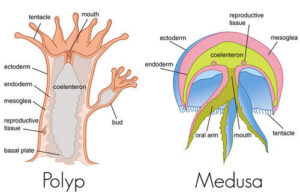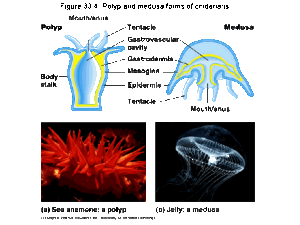Back to: ZOOLOGY 200 Level
I’m so glad to have you back for another exciting lesson. Today, we’ll be studying Polyp and Medusa Forms—two fascinating life stages found in some invertebrates, particularly cnidarians like jellyfish and corals. These forms may look different, but they share a lot in terms of their biological roles and development. Let’s get started!
Polyp and medusa forms
What are polyp and medusa forms?
In cnidarians, such as jellyfish, corals, and sea anemones, the life cycle typically includes two distinct forms: the polyp and the medusa. These two forms are specialised for different functions and habitats, and they are both essential for the organism’s survival and reproduction.

The polyp is usually a sessile (stationary) form. It attaches itself to a surface, like a rock or the ocean floor, using a structure called a pedal disc. Polyps typically have a cylindrical shape and possess a mouth surrounded by tentacles. This form is adapted for feeding, as polyps can catch small prey, such as plankton, with their tentacles.
On the other hand, the medusa is a free-swimming form. It has a bell-like shape and moves through the water by contracting its body, a process known as jet propulsion. Medusae have tentacles that trail behind them, which they use to capture prey. This form is more mobile and is generally responsible for reproduction, as medusae release eggs and sperm into the water.
The life cycle of polyp and medusa forms
Cnidarians exhibit a fascinating life cycle that involves both the polyp and medusa stages. In many species, such as jellyfish, the life cycle begins with a fertilised egg that develops into a free-swimming larva called a planula. The planula settles onto a surface and develops into a polyp.
The polyp then reproduces asexually by budding off new medusae. These new medusae eventually detach from the polyp, become free-swimming, and mature into adult medusae. The medusa stage is typically responsible for sexual reproduction. It releases eggs and sperm into the water, where fertilisation takes place. The resulting fertilised egg becomes a planula, starting the cycle over again.
In corals, polyps live in colonies, with each individual polyp forming a tiny part of the coral reef structure. Corals rely on the polyp stage to form their colonies and build massive, complex coral reefs over time.
Differences between the polyp and medusa forms
While both forms share common features, they have key differences:

- Shape and mobility: Polyps are cylindrical and are usually stationary, while medusae are bell-shaped and can move freely through the water.
- Function: Polyps are adapted for feeding and staying attached to a surface, while medusae are specialised for reproduction and movement.
- Reproduction: Polyps reproduce asexually, producing medusae, while medusae reproduce sexually by releasing eggs and sperm into the water.
Summary
The polyp and medusa forms are different life stages in cnidarians like jellyfish and corals. The polyp is stationary and primarily involved in feeding and asexual reproduction, while the medusa is free-swimming and focused on sexual reproduction. Both forms are essential in the organism’s life cycle and survival.
Evaluation
- What is the primary role of the polyp form in cnidarians?
- Describe the difference between the polyp and medusa forms.
- How does the life cycle of jellyfish involve both the polyp and medusa stages?
- In which form do cnidarians typically reproduce sexually?
You’ve learned how these fascinating creatures alternate between forms to ensure their survival. Keep up the excellent work—each lesson is a step closer to mastering Zoology. Afrilearn is with you every step of the way. Ready to continue?
